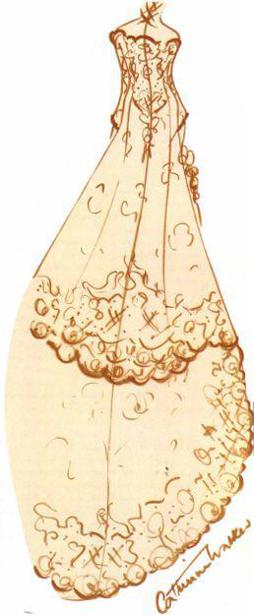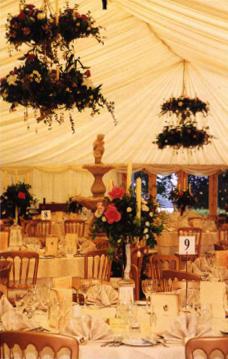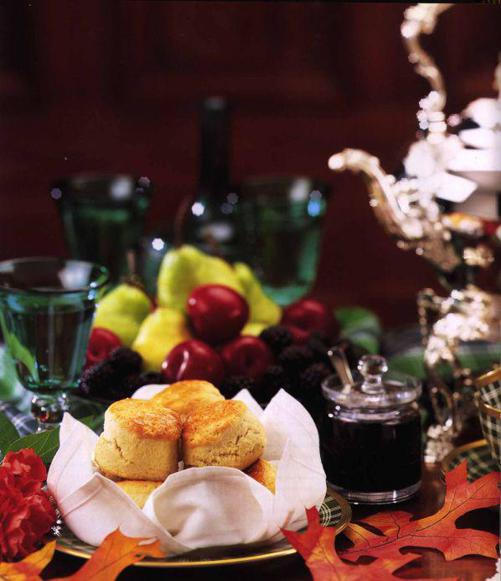In The Royal Manner (17 page)

The groom is then asked to stand and speak on behalf of his new wife. He thanks both sets of parents, his best man and may want to remember someone dear or elderly, or an absent friend. He toasts the health of the bridesmaids and everyone stands, bar the bridesmaids. Often small gifts are given at this point as a further token of thanks. It is also at this point that the bride and groom may wish to present their mothers with a bouquet of flowers to thank them for their help and support.
Inevitably the day revolves around the bride, and although not traditional, she may like to say a few words herself. The important things to remember are to be confident, relaxed and speak slowly and clearly. This speech will surprise everyone and will be very warmly received.
The last speech comes from the best man, and is traditionally the most amusing and jovial. This is his opportunity to shine and tell some amusing stories about the groom and the bride. He speaks on behalf of the bridesmaids and thanks them for carrying out their duties. To conclude, he may read a selection of cards and telegrams from a pre-selected bundle sent by those who were unable to attend the wedding. He will propose a toast to the bride, and everyone then stands to raise their glass to her.
After the speeches, the wedding cake is cut by the bride and groom, and then the rest of the cake is cut up into smaller pieces by the caterers and distributed amongst the guests. The Royal Family usually give their guests a piece of wedding cake in a monogrammed box as a keepsake of the day.
Towards the ends of the reception, the bride may wish to toss her bouquet over her shoulder to a gathered ensemble of unmarried ladies. The one who catches the bouquet is, by tradition, the next to marry. However, some brides prefer to place their bouquet on the grave of a loved one. Royal brides always have their bouquets placed on the tomb of the Unknown Soldier in Westminster Abbey.

Catrina Skepper's exquisite wedding dress by Catherine Walker features an Épaules dÉnudÉes neckline, fitted bodice, transparent fluted sleeves and low-cut back that gently cascades into a flowing skirt. The dual twin is hand-scalloped with intricate floral cording. The Lyon lace is illuminated with 44,000 pearl and crystal beads and was meticulously re-embroidered by hand with 300m of duchess satin cording to echo the elongated silhouette. (Wedding to Alessandro dei Conti Guerrini Maraldi, Brampton Oratory, Saturday 24 April 1999.)
BEST MAN

Traditionally the best friend or brother of the groom – although there is no hard and fast rule that the best man has to be male! – and has much of the responsibility regarding the groom's welfare on his shoulders. He organizes the ‘stag night’ – the all-male celebration of the groom's last night of bachelorhood. The bride would be well advised to persuade the best man to organize it at least a week before the wedding to give her intended enough time to recover from his ordeal.
On the wedding day, the best man is responsible for the groom. He ensures that the groom is dressed in the appropriate attire and that he and the groom have a buttonhole to wear. He is entrusted with the wedding rings and hands them to the priest or vicar during the wedding service. He pays the appropriate fees to them, and to the choir, bell ringers and church wardens for their services on the day. He advises the ushers and ensures that the event is running to time.
The best man may wish to place a bottle of champagne and two glasses in the wedding vehicle for the newly weds’ journey from the church to the reception. He arranges all other aspects of transport for the rest of the bridal party as well. If there is honeymoon luggage, he makes sure that it goes to the correct venue, and that it is safely secured.
Finally, his main duty on the day is to provide an entertaining and witty speech of about five minutes in length at the reception.
CHIEF BRIDESMAID
Chosen by the bride, either a best friend or sister. If she is married, she is rather old-fashionedly called ‘Matron of Honour’. Her responsibilities are to the bride what the best man's are to the groom. She organizes the ‘hen night’ – a celebration amongst female friends. She checks the bridal flowers and corsages and will assist the bride and any other bridesmaids to dress.
She travels with the other bridesmaids alongside the bride's mother to the church. The bride's dress, train and veil may need attention before the walk down the aisle and she should see to this. At the altar, the bride passes her bouquet to the chief bridesmaid. This is then handed back later on, ready for the signing of the register.
If there is a change of clothing or honeymoon luggage to coordinate, she should organize
this in
conjunction with the best man.
USHERS
Chosen from friends and family, they are in charge of seating the families in their correct places. One is designated with the task of showing the bride's mother to her seat. They may also be in charge of the transport arrangements to and from the church, and the handing out of the service and prayer books.
When the guests arrive at the church, the ushers should ask them whether they are with the bride or groom's family, and then see them to their seats.
WEDDING SUPERSTITIONS
If you're superstitious, then these quirky pieces of information will be of interest to you:
• It is bad luck for the groom to see his bride on the morning of their wedding day, especially in her wedding dress. His first sight of her should be as she approaches the altar steps or the minister in charge of the ceremony.
• Traditionally the sign of purity, the white wedding dress was made popular by Queen Victoria when she married Prince Albert. It is said to be unlucky for anyone to wear green when attending a wedding.
• A bride should not cry on the morning of her wedding as this is bad luck. She must also leave through the door of her home, leading with the right foot to ensure good fortune.
• A black cat, rainbow, chimney sweep, toad or spider is a symbol of good luck if seen by the bride on her wedding day. If she is woken up by songbirds, then good fortune will smile on her.
• There is a saving, ‘Happy is the bride whom the sun shines on’, but in Germany, if rain falls on the bride, this is considered a blessing.
• Bad luck is said to prevail if a pig or funeral party crosses in front of the wedding car.
• There is an old wives’ tale that says that if a bridesmaid sleeps on a piece of wedding cake, she will dream about the man she will marry. It is also said: ‘Three times a bridesmaid, never a bride’.
• It is good luck for the groom to carry his new wife over the threshold of their home for the first time.
• The most famous bridal superstition is that she should wear something old, new, borrowed and blue for luck.
WEDDING ANNIVERSARIES
It is especially romantic to remember your wedding day each year by surprising each other with a gift made from the material associated with that anniversary’. Here is a guide to help you with your choice:
| First | Cotton |
| Second | Paper |
| Third | Leather |
| Fourth | Silk or Flowers |
| Fifth | Wood |
| Sixth | Sugar or Iron |
| Seventh | Wool or Copper |
| Eighth | Bronze |
| Ninth | Pottery |
| Tenth | Tin |
| Eleventh | Steel |
| Twelfth | Silk, fine linen or leather |
| Thirteenth | Lace |
| Fourteenth | Ivory |
| Fifteenth | Crystal |
| Twentieth | China |
| Twenty-fifth | Silver |
| Thirtieth | Pearl |
| Thirty-fifth | Coral |
| Fortieth | Ruby |
| Forty-fifth | Sapphire |
| Fiftieth | Gold |
| Fifty-fifth | Emerald |
| Sixtieth | Diamond |
| Seventieth | Platinum |
The gold wedding ring symbolizes the circle of life. Royal wedding rings are traditionally made from a nugget of Welsh gold, and are fashioned by Garrard, the Crown Jeweller.


The greens of summer are replaced by the rich, dark and golden hues of autumn. Hedgerows are laden with berries and orchards are abundant with fruit.
At the end of the social season in London, the Royal Household moves lock, stock and barrel to the Scottish Highlands and the idyllic setting of Royal Deeside. This is the Queen's private summer residence, although the affairs of State continue and Her Majesty is never ‘off duty’. This is primarily a time for the Royal Family to relax and enjoy the invigorating Highland air. Wild berries grow profusely on the moors and in the hedgerows. Blackberries, blueberries and raspberries are particular favourites at breakfast and teatime, whether in a natural compote or gently stewed into a preserve. Stags are stalked to provide venison for the Royal table and the River Dee is fly fished for the world's best-known salmon.
Before the legendary Scottish mists descend and winter takes a hold, an outdoor life will have been enjoyed by everyone.
A GRAND VICTORIAN-STYLE CENTREPIECE
Although this grand centrepiece looks very complicated it really is simple to execute. The skeleton for this structure is merely two cake stands placed on top of one another and they are divided by large dinner platters or plate liners. Much of this will be unseen in the finished piece, so it really doesn't matter what you use to form the base. It is, however, better to select plates with a slight dip so that the arrangement can retain some water. The Victorians loved to mix fruit and flowers together in their arrangements in order to enhance the dining table and to reflect the grand luxury of the era.
